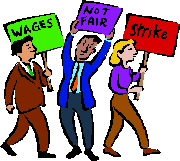By Scott Marshall
I don’t know if Steven Greenhouse, of the New York Times, writes his own headlines. Doubt it. But I was sure struck by his article headlined, “In America, Labor has an Unusually Long Fuse.” (Read it here.) It reminded me that Friedrich Engels once said something to the effect that American workers are slow to move, but when they do, they move with “seven-league boots.” Meaning they move very quickly and cover a lot of ground.
The gist of the Times article was to say that American workers are not as militant or as action oriented as their counterparts in Europe. The article cites the wonderful labor demonstrations at the G20 meeting in London and the million workers in France who demonstrated against lay-offs and the economic response of their government. It also mentions the recent actions of French workers; holding their bosses captive to draw attention to their grievances.
The article misses on a couple of counts. Workers and unions are learning from each other all the time. Modern communications doesn’t only allow the media to do its job faster, it also lets workers exchange ideas and experiences globally. Marx and Engels even mention this duality of modern communications in the Communist Manifesto. Somewhere a boss is cursing Greenhouse for the article. The actions in France and England are not lost on American workers.
Europe and America have very different union histories and experiences. The Times article does discuss some of the militant history of US labor. But in a way that makes it seem like US labor militancy, strikes, sit-ins, general strikes, marches and demonstrations etc, are a thing of the past. This is the biggest miss of the article. Militant direct action is just one tool in labor’s arsenal. Labor in both Europe and the US are too far advanced to be confined to one set of tactics. The article mentions the recent successful sit-in by Republic Window workers in Chicago to stop the owners from moving equipment to a non-union operation and to demand pay and benefits due them in the plant closing. But it fails to mention some pretty big militant demonstrations by labor in the recent past – The Battle in Seattle and the Anti-FTAA (Free Trade Agreement of the Americas) in Miami to name a couple. The thing is theseactions took place during the Clinton and Bush years – very different political times.
To put it another way: there is a big difference between French president Nicolas Sarkozy and American president Barack Obama. One is a conservative who is trying to undue years of political gains for labor and one is advancing an agenda that undoes years of attacks on labor and actually promises reforms very much in line with the interests of labor.
The article even acknowledges in the last paragraph that much of the energy and drive of labor in the recent past went into the 2008 elections. Well yea! What an understatement.
The big miss here is not to appreciate the radical transformation taking place in American labor today. Unfortunately it’s not just the New York Times that misses – it is also some of labors friends and allies on the left. Big things are happening in labor when the movement takes the path of political action to fight for its interests. The 2008 election fight was labor at its strongest and most militant since the 1930’s. Even with its small numbers US unions were central and critical not only in defeating the Republican far right and electing Obama, but labor was instrumental in changing the balance in Congress. Labor’s operations gained in political sophistication and trained tens of thousands of new union members in independent political action. Further labor’s election work and its ongoing efforts on the Employee Free Choice Act, health care reform, green jobs and development, show a growing class consciousness. American labor increasingly sees itself as the champion of all working people.
Now back to Engels. He was right. The New York Times should not worry. American labor is fully capable of using more militant tactics as the need arises. Yes American workers will continue to work politically within the system to fight for its interests. Yes US labor understands the importance of having a friend in the White House and building pressure for its agenda in Congress. But rest assured that the Republic Windows union workers are just the tip of the iceberg of worker militancy. Mass militant action remains a well known part of American Labor’s vocabulary. It would be a big mistake for the captains of industry and finance to underestimate American workers when they put on their seven league boots.
From the Labor Commission of the CPUSA, updates, information, news, analysis, and organizing materials in solidarity with workers of the world.
Wednesday, April 8, 2009
Of Long Fuses and Seven League Boots
Labels:
American workers,
labor militancy,
New York Times,
US Labor
Subscribe to:
Post Comments (Atom)


No comments:
Post a Comment